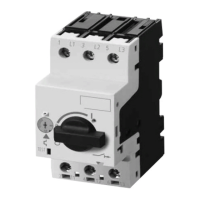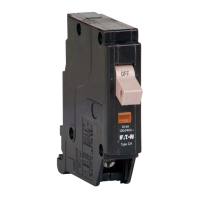energy available in terms of over travel in inches to
close the breaker contacts to their full extent. It may
be used periodically to monitor the
health
of the mecha-
nism.
At times, circuit breakers are called upon to operate
MOC switches (mechanism operated control switches)
that place extra load upon the closing mechanism of the
circuit breaker. If this load is excessive, it can prevent
the circuit breaker from closing fully. In such a case, it
is important to determine that the circuit breaker will
close fully. The CloSure
TM
Test provides this assurance.
General Information: The CloSure
TM
Test can be per-
formed on the VCP-W, VCP-WR, VCPW-ND, DHP-VR,
W-VACR, and W-VAC lines of vacuum circuit breakers
Refer to Table 6.4 a for list of circuit breakers. If the
CloSure
TM
travel obtained is as specified, the mecha-
nism performance is satisfactory. If the CloSure
TM
travel does not conform as shown in Figure 6-12, con-
tact Cutler-Hammer for further information. (See Step
13).
DO NOT ATTEMPT TO INSTALL OR PERFORM
MAINTENANCE OR TESTS ON THE EQUIPMENT
WHILE IT IS ENERGIZED. NEVER PUT YOUR
HANDS NEAR THE MECHANISM WHEN THE CIR-
CUIT BREAKER IS IN THE CHARGED OR CLOSED
POSITION. DEATH OR SEVERE PERSONAL INJURY
I.B. 32-255-1G
Page 38
Effective 12/02
secondary disconnect pins with shooting wire. Connect
this wire to the high potential lead of the test machine.
Ground the circuit breaker frame. Starting with zero,
increase the voltage to 1125 volts rms, 60 Hz. Maintain
the voltage for one minute. Successful withstand indi-
cates satisfactory insulation strength of the secondary
control circuit. Remove the shooting wire and reconnect
motor leads.
6-8 PRIMARY CIRCUIT RESISTANCE CHECK
Since the main contacts are inside the vacuum cham-
ber, they remain clean and require no maintenance at
any time. Unlike many typical circuit breaker designs,
VCP-W breakers do not have sliding contacts at the
moving stem either. Instead they use a highly reliable
and unique flexible clamp design that eliminates the
need for lubrication and inspection for wear.
If desired, the DC resistance of the primary circuit may
be measured as follows: close the circuit breaker, pass
at least 100 amps DC current through the circuit break-
er. With a low resistance instrument, measure resis-
tance across the studs on the circuit breaker side of the
disconnects for each pole. The resistance should not
exceed the values shown in Table 6.3.
6-9 MECHANISM CHECK
Make a careful visual inspection of the mechanism for
any loose parts such as bolts, nuts, pins and rings.
Check for excessive wear or damage to the circuit
breaker components. Operate the circuit breaker sever-
al times manually and electrically. Check the closing
and opening times to verify that they are in accordance
with the limits in Table 5.2.
6-9.1 CLOSURE™ TEST
Introduction: The CloSure
TM
Test is a simple yet
extremely effective means to determine and monitor the
ability of the mechanism to close the breaker contacts
fully. It provides a quantitative measure of the extra
Rated Continuous
Current (amperes)
1200
2000
3000
Resistance
(microohms)
60
40
20
Table 6.3 Typical Resistance Measurements

